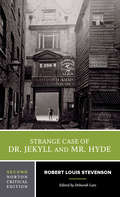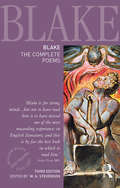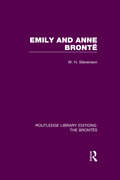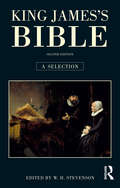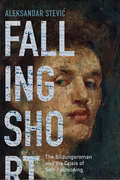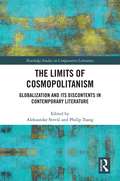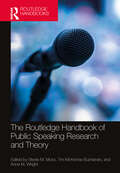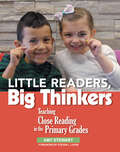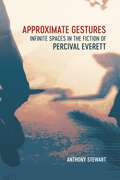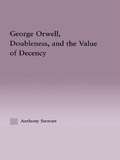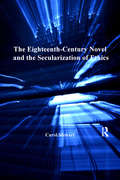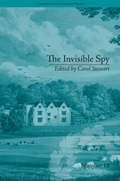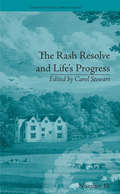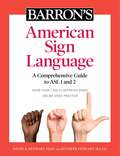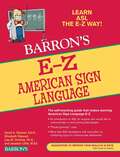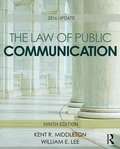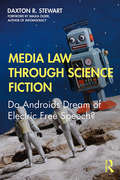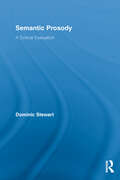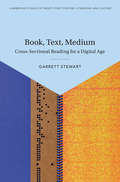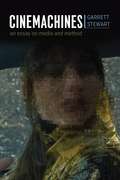- Table View
- List View
Edinburgh: Picturesque Notes
by Robert Louis StevensonFirst published in 1879, Edinburgh: Picturesque Notes is among the most vivid of Robert Louis Stevenson’s writings. His passion for Auld Reekie never clouded his wry wit, and his enthusiasm for the picturesque detail and the savory anecdote will delight readers today as much as they scandalized his contemporaries. Perhaps best known as the author of Treasure Island and other children’s literature, Robert Louis Stevenson was a prolific novelist, playwright, essayist, and travel writer.
The Strange Case of Dr. Jekyll and Mr. Hyde (Norton Critical Editions #0)
by Robert Louis Stevenson“The annotations are useful, particularly for references to biblical and other literary allusions. [The contexts] section is essential to alerting students to the many subtexts/contexts of the story.” —MARIA CARRIG, Carthage College This Norton Critical Edition includes: The first British edition of the novel, published in 1886 by Longmans, Green, and Co., the only edition set directly from Stevenson’s manuscript and for which he read and corrected proofs. Deborah Lutz’s thorough introduction and detailed explanatory footnotes to the novel. Seven illustrations. A rich and relevant selection of background materials centered on the novel’s composition, reception, and historical and cultural contexts, alongside seven of Stevenson’s letters. Interpretative essays by Elaine Showalter, Jack Halberstam, Martin Danahay, and Stephen Arata. A chronology and a selected bibliography. About the Series Read by more than 12 million students over fifty-five years, Norton Critical Editions set the standard for apparatus that is right for undergraduate readers. The three-part format—annotated text, contexts, and criticism—helps students to better understand, analyze, and appreciate the literature, while opening a wide range of teaching possibilities for instructors. Whether in print or in digital format, Norton Critical Editions provide all the resources students need.
Blake: The Complete Poems (Longman Annotated English Poets)
by W. H. StevensonWilliam Blake (1757 - 1827) is one of the great figures in literature, by turns poet, artist and visonary. Profoundly libertarian in outlook, Blake's engagement with the issues of his day is well known and this - along with his own idiosynratic concerns - flows through his poetry and art. Like Milton before him, the prodigality of his allusions and references is little short of astonishing. Consquently, his longer viosnary poems can challege the modern reader, who will find in this avowedly open edition all they might need to interpret the poetry. W. H. Stevenson's Blake is a masterpiece of scrupulous scholarship. It is, as the editor makes clear in his introduction, 'designed to be widely, and fluently, read' and this Third Edition incorporates many changes to further that aim. Many of the headnotes have been rewritten and the footnotes updated. The full texts of the early prose tracts, All Religions are One and There is no Natural Religion, are included for the first time. In many instances, Blake's capitalisation has been restored, better to convey the expressive individuality of his writing. In addition, a full colour plate section contains a representation of Blake's most significant paintings and designs. As the 250th anniversary of his birth approaches, Blake has perhaps more readers than ever before; Blake: The Complete Poems will stand those readers, new and old, in good stead for many years to come.
Emily and Anne Brontë (Routledge Library Editions: The Brontës)
by W. H. StevensonFrom the claustrophobic environment of Haworth Parsonage emerged an astonishing range and diversity of character and talent. Between them the two youngest Brontë sisters wrote three novels, each sharply individual in style, purpose and subject-matter. The title, first published in 1968, discusses and illustrates the similarities and differences in the writings of Emily and Anne Brontë, paying particular attention to their place in the development of the Victorian novel. He stresses the complexities of structure and characterisation in Wuthering Heights, introducing the reader first to the background of the novel. This book will be of interest to students of English Literature.
King James's Bible: A Selection
by W. H StevensonWithout an understanding of Biblical stories, readers lose out on much of the richness of English literature, as authors from Milton through T.S. Eliot to Jeanette Winterson draw inspiration from Biblical stories in their own writing. This user-friendly annotated selection of key passages from the King James’s Bible clarifies the key themes, characters, stories and genealogies for students, offering timelines, a bibliography, and a detailed index for quick and easy reference. The original 1984 version, of which this is a revised edition, was written by Bill Stevenson as a response to his students' difficulty with biblical references in literature - a selection from the King James’s Bible that would give the student a notion of what the book contains, including the history of the 1611 text, the strands of imagery that bind the whole together. It gives the student a brief overview of the political, historical and religious contexts of the stories in the Bible as well as a brief history of the different versions of the Bible.
Falling Short: The Bildungsroman and the Crisis of Self-Fashioning
by Aleksandar StevićA paradox haunts the bildungsroman: few protagonists successfully complete the process of maturation and socialization that ostensibly defines the form. From the despondent endings of Dickens’s Great Expectations and Meredith’s The Ordeal of Richard Feverel to the suicide of Balzac’s Lucien de Rubempré and the demise of Eliot’s Maggie and Tom Tulliver, the nineteenth-century bildungsroman offers narratives of failure, paralysis, and destruction: goals cannot be achieved, identities are impossible to forge, and the narrative of socialization routinely crumbles. Examining the novels of Stendhal, Honoré de Balzac, Charles Dickens, Charlotte Brontë, Henry James, Samuel Butler, James Joyce, and Marcel Proust, Falling Short reveals not only a crisis of character development but also a crisis of plotting and narrative structure. From the inception of literary realism in the 1830s to the height of modernism a century later, the bildungsroman presents itself as a key symptom of modern Europe’s inability to envision either coherent subjectivity or successful socialization. Rather than articulating an arc of personal development, Stević argues, the bildungsroman tends to condemn its heroes to failure because our modern understanding of both individual subjectivity and social success remains riddled with contradictions. Placing primary texts in conversation with the central historical debates of their time, Falling Short offers a revisionist history of the realist and modernist bildungsroman, unearthing the neglected role of defeat in the history of the genre.
The Limits of Cosmopolitanism: Globalization and Its Discontents in Contemporary Literature (Routledge Studies in Comparative Literature)
by Aleksandar Stevic Philip Tai-Hang TsangThis book examines the limits of cosmopolitanism in contemporary literature. In a world in which engagement with strangers is no longer optional, and in which the ubiquitous demands of globalization clash with resurgent localist and nationalist sentiments, cosmopolitanism is no longer merely a horizon-broadening aspiration but a compulsory order of things to which we are all conscripted. Focusing on literary texts from such diverse locales as England, Algeria, Sweden, former Yugoslavia, and the Sudan, the essays in this collection interrogate the tensions and impasses in our prison-house of cosmopolitanism.
The Routledge Handbook of Public Speaking Research and Theory (Routledge Handbooks in Communication Studies)
by Stevie M. Munz, Tim McKenna-Buchanan, and Anna M. WrightProviding a comprehensive survey of the empirical research, theory, and history of public speaking, this handbook fills a crucial gap in public speaking pedagogy resources and provides a foundation for future research and pedagogical development.Bringing together contributions from both up-and-coming and senior scholars in the field, this book offers a thorough examination of public speaking, guided by research across six key themes: the history of public speaking; the foundations of public speaking; issues of diversity, equity, and inclusion; considerations of public speaking across contexts; assessment of public speaking; and the future of public speaking in the twenty-first century. The evidence-based chapters engage with a broad discussion of public speaking through a variety of viewpoints to demonstrate how subtopics are connected and fraught with complexity. Contributors explore public speaking in education, business and professional settings, and political contexts, and outline how skills learned through public speaking are applicable to interpersonal, small group, and business interactions.Reinforcing the relevance, importance, and significance of public speaking in individual, interpersonal, social, and cultural communication contexts, this accessibly written handbook will be an indispensable resource for public speaking instructors and program administrators. It will also be valuable reading for Communication Pedagogy and Introduction to Graduate Studies courses.
Little Readers, Big Thinkers: Teaching Close Reading in the Primary Grades
by Amy StewartYoung learners are full of questions and wonderings, so much so that sometimes they need a guide for their curiosity. Author Amy Stewart brings her manageable approach to close reading in Little Readers, Big Thinkers: Teaching Close Reading in the Primary Grades . With Stewart guiding, you'll be able to harness the big thinking we know is inside their inquisitive minds.She showcases ways that close reading can teach even the youngest students new ways to enjoy texts, think about them critically, and share that thinking with peers and adults.With its description of the pillars of close reading, multiple lesson sequences for grades K-2, and real-life classroom scenarios, Little Readers, Big Thinkers offers a trove of insights: What close reading is (and is not )How to encourage students to read like detectives-Ways to weave close reading practices into your lessonsHow to cultivate real reading, organic thinking, and deep conversationWhich books invite amazing learning and thinking experiencesBy giving young minds a great foundation, close reading will become a stepping stone to a lifelong love of reading.
Approximate Gestures: Infinite Spaces in the Fiction of Percival Everett
by Anthony StewartIn Approximate Gestures, Anthony Stewart argues that the writing of Percival Everett, the acclaimed author of Erasure and more than twenty other works of fiction, compels readers to retrain their thinking habits and to value uncertainty. Stewart maintains that Everett’s fiction challenges its interpreters to question their assumptions, consider the spaces in between categories, and embrace the potential of a larger, more uncertain world in an effort to confront bigotry and similarly limiting patterns of thought. Drawing on the work of Gilles Deleuze and Félix Guattari, Stewart proposes that their notion of the schizorevolutionary figure captures the in-between status of many of Everett’s characters as they refuse the constraints of the binary, categorical structures that govern so much of human life. Approximate Gestures engages specifically with the vexed question of discussing race in Everett’s fiction. Stewart frames the stakes of analyzing such subject matter in the writing of an African American novelist whose work rigorously questions critical approaches to race. Requiring readers to engage with black males who are hydrologists, ranchers, college professors, romance novelists, and in one case, a toddler, means entering a world released from habitual frames of reference. Through an examination of a broad selection of novels, Stewart demonstrates the extent to which Everett’s characters inhabit “infinite spaces in between conventional categories” and understand themselves as subjects attempting to navigate social and psychological worlds. Approximate Gestures: Infinite Spaces in the Fiction of Percival Everett encourages readers and critics to think more deeply about how they position themselves in and engage with the world around them. As one of the first books of literary criticism devoted to Everett’s fiction, Stewart’s pathbreaking study models a method for reading the formidable body of work being produced by a major contemporary writer.
George Orwell, Doubleness, and the Value of Decency (Studies in Major Literary Authors #Vol. 32)
by Anthony StewartFirst Published in 2003. Routledge is an imprint of Taylor & Francis, an informa company.
The Eighteenth-Century Novel and the Secularization of Ethics
by Carol StewartLinking the decline in Church authority in the late seventeenth and early eighteenth centuries with the increasing respectability of fiction, Carol Stewart provides a new perspective on the rise of the novel. The resulting readings of novels by authors such as Samuel Richardson, Sarah Fielding, Frances Sheridan, Charlotte Lennox, Tobias Smollett, Laurence Sterne, William Godwin, and Jane Austen trace the translation of ethical debate into secular and gendered terms. Stewart argues that the seventeenth-century debate about ethics that divided Latitudinarians and Calvinists found its way into novels of the eighteenth century. Her book explores the growing belief that novels could do the work of moral reform more effectively than the Anglican Church, with attention to related developments, including the promulgation of Anglican ethics in novels as a response to challenges to Anglican practice and authority. An increasingly legitimate genre, she argues, offered a forum both for investigating the situation of women and challenging patriarchal authority, and for challenging the dominant political ideology.
The Invisible Spy: by Eliza Haywood (Chawton House Library: Women's Novels #18)
by Carol StewartInterest in the work of Eliza Haywood has increased greatly over the last two decades. Though much scholarship is focused on her ‘scandalous’ early career, this critical edition of The Invisible Spy (1755) adds to the canon of her later, more sophisticated work.
The Rash Resolve and Life's Progress: by Eliza Haywood (Chawton House Library: Women's Novels #16)
by Carol StewartEliza Haywood was one of the most popular and versatile writers of the eighteenth century. The two novellas in this edition – The Rash Resolve (1724) and Life’s Progress (1748) – show her developing and adapting her ideas on the subject of passion and romance. Though superficially presented as cautionary tales, Haywood introduces a feminist slant.
Barron's American Sign Language: A Comprehensive Guide to ASL 1 and 2 with Online Video Practice
by David A. Stewart Jennifer StewartBarron&’s American Sign Language is a brand-new title on ASL that can be used in the classroom, as a supplemental text to high school and college courses, or for anyone who wants to learn proper ASL.The only book with comprehensive instruction and online graded video practice quizzes, plus a comprehensive final video exam.Content includes topics on the Deaf culture and community, ASL Grammar, fingerspelling, combining signs to construct detailed sentences, Everyday ASL, and much more.More than 1,000 illustrations of signs with instructions on movement--step-by-step with dialogue, tip boxes, and practice exercises and quizzes throughout to reinforce retention and to track your progress.
E-Z American Sign Language, 3rd Edition (Barron's E-Z Series)
by David Stewart Elizabeth Stewart Lisa DimlingA Simon & Schuster eBook. Simon & Schuster has a great book for every reader.
The Law of Public Communication: 2016 Update
by Daxton Stewart Kent R. Middleton William E. LeeThe Law of Public Communication provides an overview of media law that includes the most current legal developments today. It explains the laws affecting the daily work of writers, broadcasters, advertisers, cable operators, Internet service providers, public relations practitioners, photographers, bloggers, and other public communicators. Authors Kent R. Middleton, William E. Lee, and Daxton R. Stewart take students through the basic legal principles and methods of analysis that allow students to study and keep abreast of the rapidly changing field of public communication. By providing statutes and cases in a cohesive manner that is understandable, even to students studying law for the first time, the authors ensure that students will acquire a firm grasp of the legal issues affecting the media. This 2017 Update brings the Ninth Edition up to date with the most recent cases and examples affecting media professionals and public communicators.
Media Law Through Science Fiction: Do Androids Dream of Electric Free Speech?
by Daxton R. StewartAttorney and legal scholar Daxton Stewart examines the intersection of media law and science fiction, exploring the past, present, and future of communication technology and policy debates. Science fiction offers a vast array of possibilities anticipating future communication technologies and their implications on human affairs. In this book, Stewart looks at potential legal challenges presented by plausible communication technologies that may arise 20 or 50 or 100 years from today. Performing what he calls "speculative legal research," Stewart identifies the kinds of topics we should be talking about relating to speech, privacy, surveillance, and more, and considers the debates that would be likely to arise if such technologies become a reality. Featuring interviews with prominent science fiction authors and legal scholars, and a foreword by Malka Older, this book considers the speculative solutions of science fiction and their implications in law and policy scholarship. Chapters feature specific literary examples to examine how cultural awareness and policy creation are informed by fictional technology, future societies, and legal disputes. Looking forward, beyond traditional legal research and scholarship to the possible and even very likely future of communication technology, this fascinating work of speculative legal research will give students and scholars of media law, science fiction, and technology much to discuss and debate.
Semantic Prosody: A Critical Evaluation (Routledge Advances in Corpus Linguistics)
by Dominic StewartSemantic Prosody is the first full-length treatment of semantic prosody, a concept akin to connotation but which connects crucially with typical lexical environment. For example, it has been claimed that the adverb 'utterly' is characterised by an unfavourable semantic prosody on account of its habitual co-occurrence with words denoting unfavourable states of affairs such as 'ridiculous', 'disgraceful' and 'miserable'. Primarily for this reason, semantic prosody has emerged almost exclusively within the field of corpus linguistics. However, the overall picture is complex, and this book offers a much-needed review of how semantic prosody has been described and approached in contributions on the subject, as well as a critical analysis of those contributions and a number of case studies. It discusses the relevance of the theory of priming in this area, and whether semantic prosody has cogency as a theoretical concept. Lastly, it points the way for future research. Since work on semantic prosody so far has been occasional, brief, and distributed across a range of monographs, articles and conference papers, this book, which does not assume previous knowledge of the subject, will constitute a fundamental work of reference for scholars, teachers and students alike. At the same time, Semantic Prosody goes beyond the central topic of the work, with wide-reaching implications for both corpus linguistics and linguistics overall. In this sense the concept of semantic prosody is used as a springboard for investigations into issues of vital importance for corpus studies such as the structuring and presentation of text in a corpus, the varying methodologies adopted by analysts to approach and interpret corpus data, as well as broader issues such as the role of intuition, introspection and elicitation in empirical language studies.
Book, Text, Medium: Cross-Sectional Reading for a Digital Age (Cambridge Studies in Twenty-First-Century Literature and Culture)
by Garrett StewartBook, Text, Medium: Cross Sectional Reading for a Digital Age utilizes codex history, close reading, and language philosophy to assess the transformative arc between medieval books and today's e-books. It examines what happens to the reading experience in the twenty-first century when the original concept of a book is still held in the mind of a reader, if no longer in the reader's hand. Leading critic Garrett Stewart explores the play of mediation more generally, as the concept of book moves from a manufactured object to simply the language it puts into circulation. Framed by digital poetics, phonorobotics, and the rising popularity of audiobooks, this study sheds new light on both the history of reading and the negation of legible print in conceptual book art.
Cinemachines: An Essay on Media and Method
by Garrett StewartThe hero stands on stage in high-definition 3-D while doubled on a crude pixel screen in Billy Lynn’s Long Halftime Walk. Alien ships leave Earth by dissolving at the conclusion of Arrival. An illusory death spiral in Vertigo transitions abruptly to a studio set, jolting the spectator. These are a few of the startling visual moments that Garrett Stewart examines in Cinemachines, a compelling, powerful, and witty book about the cultural and mechanical apparatuses that underlie modern cinema. Engaging in fresh ways with revelatory special effects in the history of cinematic storytelling—from Buster Keaton’s breaching of the film screen in Sherlock Jr. to the pixel disintegration of a remotely projected hologram in Blade Runner 2049—Stewart’s book puts unprecedented emphasis on technique in moving image narrative. Complicating and revising the discourse on historical screen processes, Cinemachines will be crucial reading for anyone interested in the evolution of the movies from a celluloid to a digital medium.

